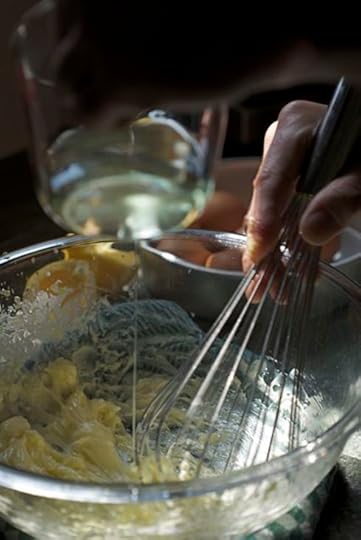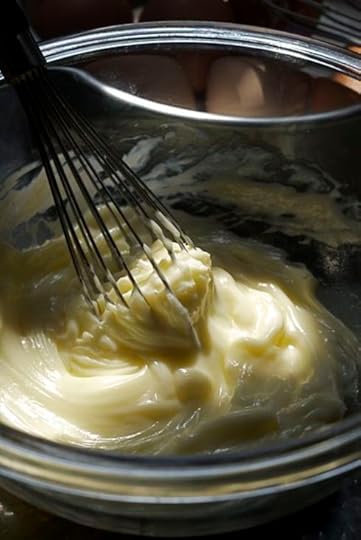Michael Ruhlman's Blog, page 43
April 2, 2013
How Important Is Garlic?

This is perfect garlic. Photo by DonnaTurner Ruhlman.
Garlic has changed for me. Now that really good, hard-stemmed varieties are available, I love to use it just briefly cooked. I find that in the traditional uses—in mirepoix for stews and sauces—it is completely lost. That’s right, I almost never use it in tomato-based sauces—the onion does all the heavy lifting. If I want garlic in a sauce or a braise I add it late in the game. My favorite way to cook garlic is briefly and in abundance, so you can taste it. Cooked this way it’s the powerhouse we’ve always thought of it as. I love it just briefly cooked in oil and used with pasta or smeared on toast. Donna and I used it in great abundance with tomatoes and basil—the season is near! Here’s the video that uses the fantastic technique of mounting butter into tomato water.
The garlic you buy should look just like the above, big and thick with a hard stem, tight skin, solid cloves. When you cut into it, it should be juicy. The smaller and whiter the germ, the younger the garlic. Can’t wait for garlic to be back in season.
Just home from vacay with Mom and back to work, photography for the new book, but had to post this great shot from Donna. Very excited about tomorrow’s guest post on the almighty ham.
If you liked this post, you might be interested in these links:
My post on making Cuban Picadillo.
Check out Cleveland’s Annual Garlic Festival this September.
Here’s a recipe for Garlic Soup with Spinach from the New York Times.
© 2013 Michael Ruhlman. Photo © 2013 Donna Turner Ruhlman. All rights reserved.
March 29, 2013
Chicken Sausage

Homemade chicken sausages. Photo by Donna Turner Ruhlman.
Today my Friday cocktail will be a daiquiri here in Palm Beach. Instead sit down with a Lagunitas IPA and a few homemade chicken sausages, this recipe originally appears in Charcuterie.
Chicken Sausage with Basil and Tomatoes
3 1⁄2 pounds/1.5 kilograms boneless, skinless chicken thighs, cubed
1 1⁄2 pounds/675 grams pork back fat, cubed, diced into 1-inch pieces
3 tablespoons/40 grams kosher salt
1 teaspoon/3 grams freshly ground black pepper
1 1⁄2 teaspoons/9 grams minced garlic
4 tablespoons/24 grams tightly packed chopped fresh basil
1⁄2 cup/100 grams fresh diced roma (plum) tomatoes
1⁄4 cup/60 grams diced sun-dried tomatoes
1⁄4 cup/60 milliliters red wine vinegar, chilled
1⁄4 cup/60 milliliters extra virgin olive oil
1⁄4 cup/60 milliliters dry red wine, chilled
10 feet/3 meters hog casings, soaked in tepid water for at least 30 minutes and rinsed
Combine the meat, fat, salt, pepper, garlic, basil, and tomatoes and toss together until evenly mixed. Chill until ready to grind.
Grind the mixture through the small die into a bowl set in ice.
Using the paddle attachment of a standing mixer (or a sturdy spoon), mix on low speed (or stir) for 1 minute. Add the vinegar, oil, and wine, increase the speed to medium, and mix for 1 more minute, or until the liquid is incorporated and the sausage has a uniform, sticky appearance.
Fry a bite-sized portion of the sausage, taste and, adjust the seasoning if necessary.
Stuff the sausage into the hog casings and twist into 6-inch/15-centimeter links. Refrigerate or freeze until ready to cook.
Cook the sausage to an internal temperature of 160 degrees F./71 degrees C. yield: About 5 pounds/2.25 kilograms sausage; about twenty 6-inch/15-centimeter links.
Other great links to check out:
My books on Schmaltz and Salumi.
Looking for another cocktail for the holiday try the party punch aka Scamper Juice.
Try making your own bacon at home, its easier then you think.
It is key to have a nice grinder at home not just for making sausages, but hamburgers too.
© 2013 Michael Ruhlman. Photo © 2013 Donna Turner Ruhlman. All rights reserved.
March 27, 2013
Bake Your Own 5:3 Bread
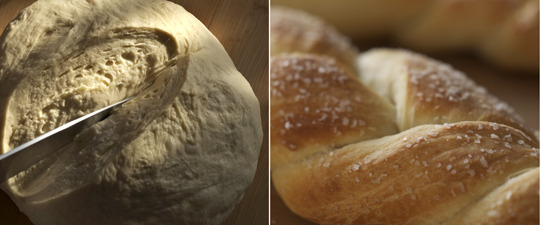
Bread basics on the rise and ready to go. Photo by Donna Turner Ruhlman.
Taking a bit of a break with Ma in West Palm—Goodbye, Cleveland grays!—but wanted to keep up the culinary inspiration via Donna’s photos. Here a basic bread ratio of 5 parts flour to 3 parts water can be turned into pizza dough, flat bread, or even a braided loaf with kosher salt
My Bread Baking App has more info or watch this video.
Or have a look at these past bread posts: pretzels, multigrain bread, no knead bread, and challah.
What is The Book of Schmaltz? Find out on Vimeo; then win a copy of the app from Edamam’s giveaway on Pinterest.
March 25, 2013
The Humanizing Impact of Soup

Soup is the easiest of meals to prepare and one of the most important: This fancy-looking soup is simply celery root cooked with onion and milk, pureed, strained, and poured over some diced celery root for garnish. Photo by Donna Turner Ruhlman.
Carri Thurman, baker and chef at Two Sisters Bakery in Homer, Alaska, asked to write about soup after what I can only say is a soup moment. It’s also a glimpse of a busy bakery and kitchen (and two delicious recipes for tomato soup and a seafood soup). —M.R.
The Magic of Soup
I arrive at the bakery at 10 a.m to begin my day working the lunch and dinner kitchen shifts.
As I get out of my car, the roar of the waves breaking on the beach next door fills my ears and the stinging odor of salt water assaults my nose. As I get closer to the building the fishy smell of the ocean mingles with that of sweet warm sticky buns tinged with ham Danish that has been left in the toaster oven a little too long. The crashing sound of the surf is quickly replaced by the loud din of a busy kitchen, pans banging and the hissing of steam from the espresso machine. Baristas are yelling to be heard over the noise, “Would you like that for here or to go?”
It was nearly impossible to park and there is a large group of people trying to squeeze in the main entrance so I slip in the back door. The pastry girl is at the wooden rolling table, working her dough, cheeks smudged with flour. “It’s been crazy all morning, you might just want to turn around and run the other way.”
I drop my bags and wash my hands, drying them as I rush, head down toward the stove to quickly assess the situation. Looking up through the open kitchen I see the line of customers snaking out to the back porch; their faces look wide-eyed and curious. And hungry. I feel a little like an army doctor performing a triage. I’ve been out of the kitchen for a couple of days so I need to get up to speed, fast. “How much soup do we have for today?” I ask. One look from Ben, my lunch cook, and I know we have nothing.
As he gives me the status on the rest of the morning, I am already gathering what I need: onions, peeled garlic, a couple of big cans of diced tomatoes, cream cheese. I quickly get out my biggest soup pot, pour in a healthy dose of olive oil, and get it heating on the stove. I set up my cutting board and roughly chop the onions, throw them in the pot, after a minute or two add the garlic, don’t chop, just smash. I stir and sauté until the onions are translucent and deglaze the whole mess with a little white wine. While this is cooking, I open up the cans of tomatoes and set them aside for when I’m ready to pour them into the pot. I take the cream cheese and cut it into chunks so it will quickly warm when I put it in the soup. The smell of the onion and garlic in the air weave their magic and lull the crowd; people start to smile and ask “What are you cooking back there that smells so good?” I just grin back and say, “Soup!” Several minutes later, the soup is done, the spell complete: 4 gallons of Creamy Tomato Basil Soup in under 30 minutes.
That would be some ancient magic, too, according to a radio piece I recently heard on NPR. Apparently researchers believe that for at least 25,000 years we have been making soup. They point out the information from primatologist Richard Wrangham in his book Catching Fire, that cooking food, or quite possibly making soup is what actually allowed us to evolve into the humans we are. There, I said it. (I know Michael will agree with me because he all but says it too in this thoughtful post.)
Even with all that, people seem intimidated to make it from scratch these days and I believe one of the reasons is that they unnecessarily complicate the process. Really, it is a simple marriage of ingredients, cooked well, seasoned well, and served well, easy as that. To keep things as uncomplicated as possible I rarely use stock. I do like to make a quick stock for meat or fish soups by using the trim from the ingredients I’m prepping for the soup itself and then straining that mixture right into the pot after sautéing the vegetables. With all the dietary issues that have arisen for people lately, I never use prepared stocks or pastes at the bakery because I’m never sure what they contain.
Here I’d like to share the recipes for two of our most popular soups, the quick and simple tomato soup I describe above and a warm and spicy rockfish chowder, a great way to use any seafood you have available.
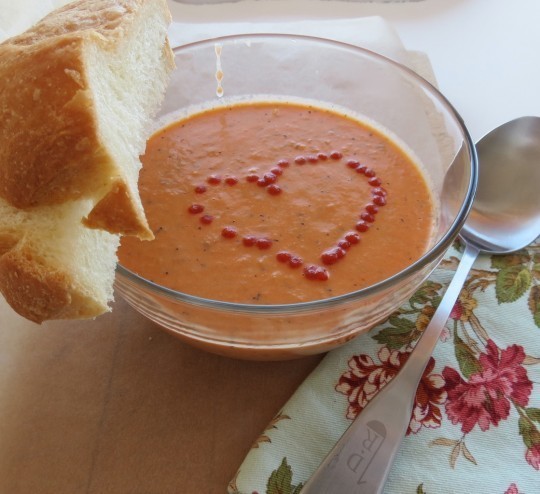
Tomato basil soup. Photo by Carri Thurman.
Creamy Tomato Basil
2 tablespoons olive oil
2 cups chopped yellow onion (about 1 large onion)
4 garlic cloves, peeled and smashed
Two 16-ounce cans diced tomatoes
1 cup water
1 tablespoon dried basil leaves
2 teaspoons salt
Pinch sugar
4 ounces cream cheese, softened
Heat the oil in a 6-quart heavy-bottom pot over medium heat.
Add the onion and garlic and sauté until onions are translucent and the kitchen smells delicious, about 5 minutes.
Add the tomatoes, water, basil leaves, salt, and sugar. Bring to a simmer, reduce the heat to medium-low, and cook for 15 minutes.
Turn off the heat and tuck the chunks of cream cheese into the hot soup, being careful not to splash.
Let sit off the heat for 5 minutes, then puree with an immersion blender.
Garnish with a grilled cheese sandwich.
Makes about 2½ quarts or 5 to 6 bowls of soup.
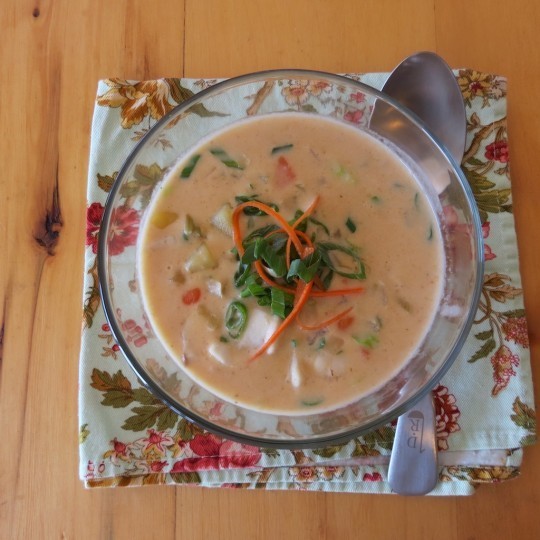
Fish curry soup. Photo by Carri Thurman.
Red Curry Rockfish Chowder
2 cups diced yellow onion (about 1 large onion)
3 large carrots, peeled and diced
3 celery ribs, diced
2 tablespoons minced ginger
2 tablespoons minced garlic
1 tablespoon red curry paste
1 tablespoon salt
Pinch sugar
¼ cup white wine
⅓ cup flour
6 cups fish stock or water
4 medium potatoes, peeled and diced
1 pound rockfish, cut into dime-sized chunks (or any fish really, salmon works great!)
12 ounces coconut milk
Juice of ½ lime
Cilantro or scallion for garnish
Make a quick stock by placing the fish bones and discarded pieces in a medium pot with the scraps from your vegetables, cover with cool water … about 6½ cups. Bring to just under a simmer and cook while you prep the rest of the ingredients.
Chop all your vegetables and assemble the rest of the ingredients near the stove where you will be working.
Heat a 6-quart soup pot over medium-high heat. Add the onions and sauté for 2 minutes.
Add the carrots, celery, ginger, garlic, curry paste, salt, and sugar and continue to sauté for another 5 minutes until onion is translucent and your husband comes in and asks what smells so good.
Pour in the white wine to deglaze the pan and cook off almost all of the liquid, about 1 minute.
Sprinkle the flour over the vegetables in the pan and stir thoroughly to coat.
Strain the fish stock through a sieve right into your soup pot, stirring well to incorporate and keeping the flour from sticking to the bottom.
Add the potatoes, reduce the heat to medium-low, and continue to cook, stirring very frequently, until the potatoes are tender, about 20 minutes. Add a little water if it gets too thick.
Into the simmering soup carefully add the rockfish and return the soup to a light simmer for 5 minutes to thoroughly cook the fish.
Finish with the coconut milk, add a squeeze from half a lime, and top with a handful of fresh cilantro or scallion.
Makes about 4 quarts or 8 big bowls of soup.
If you liked this post, you might be interested in these links:
My post on matzo ball soup and Schmaltz.
Homesick Texan shares a recipe for buttermilk potato soup.
Roasted beet soup, an easy soup to make at home.
Food Timeline shares their research on the history of soup.
© 2013 Michael Ruhlman. Photo © 2013 Donna Turner Ruhlman. All rights reserved.
March 22, 2013
Friday Cocktail Hour: The Tom Collins
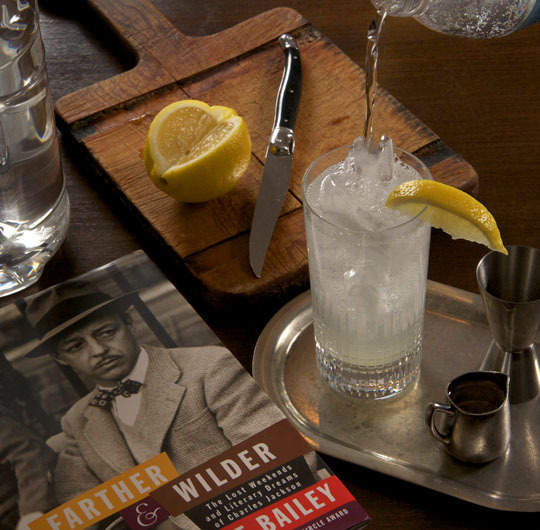
A Tom Collins, a favorite of Charles Jackson.
Photo by Donna Turner Ruhlman.
Today’s cocktail is in honor of my best friend’s latest biography out this week, Farther & Wilder: The Lost Weekends and Literary Dreams of Charles Jackson. Jackson is all but forgotten but was the toast of Hollywood for a time and a highly regarded novelist, best known for The Lost Weekend. The Wall Street Journal calls Blake Bailey’s book “brilliant and gripping,” which is all the more amazing in that the story is largely about literary failure. The Lost Weekend was until now Jackson’s only enduring legacy, and remembered only because a great movie was made of it.
Blake, whom the Daily Beast and his next subject, Philip Roth, both called the best biographer working today, also wrote the award-winning Cheever biography, and his non-award-winning bio of Richard Yates, which was even better than Cheever in my opinion (shows you what awards are worth).
Charlie Jackson’s The Lost Weekend was the first work of fiction to treat alcoholism as something that could be treated rather than an incurable personality trait and the stuff of comedy in the movies. The travails of the protagonist, Don Birnam, are so riveting, so mortifying and precise, it’s hard to believe it wasn’t lived in full by the author. Indeed, but for a single scene it is a narrative of actual events in the life of Charles Jackson, an alcoholic, closeted gay man (the subject of his second novel), married with two daughters, who for most of his life lived mired in debt and deep inner loneliness.
To celebrate the publication of the book—not alcohol or alcoholism—I asked Blake what was Jackson’s favorite cocktail, what I might choose in honor of the now not-forgotten author:
“Charlie’s favorite cocktail, it’s a little tricky,” Blake wrote in an email. ”Don Birnam generally doesn’t fuck around with cocktails—straight rye for him—but when he goes to that elegant bar in the village he orders a ‘gin vermouth,’ and we know from that souvenir bar tab from the Dolder in Zurich that Charlie was also partial to gin vermouths as well as Manhattans. (I presume a gin vermouth was an earlier, more vermouth-heavy version of the martini?) Toward the end of his life, however, he was drinking Tom Collinses for breakfast (see top of p. 410), and that’s what I think you should offer your readers: a solid Tom Collins.”
A warning: do not have these for breakfast unless you want to wind up like Jackson, a long-washed-up writer dead of a drug overdose in the Chelsea Hotel at age 65. Blake makes it very clear that Jackson wrote The Lost Weekend only after having gotten sober (the book notes that Jackson’s 1959 Alcoholics Anonymous address to a Cleveland audience is available online). He couldn’t write worth a damn while drinking or while on pills. Aspiring writers take note: alcohol has destroyed countless American scribes.
Moreover, forced sobriety prevents you from enjoying The Hour! One of the few reliable pleasure in, as Blake often calls it, this vale of tears. So imbibe moderately.
Herewith, the Tom Collins, in effect lemonade and gin, made lively with soda water, especially refreshing in summer (or, of course, at book parties).
Congrats, Blake!
Tom Collins
60 grams/2 ounces gin
30 grams/1 ounce freshly squeezed lemon juice
30 grams/1 ounce simple syrup (or 2 teaspoons sugar dissolved in the lemon juice)
60 to 120 grams/2 to 4 ounces seltzer water
Lemon wedge, for garnish
Combine the gin, lemon juice, and simple syrup (or sugar) in a highball glass, and stir well to combine.
Add the seltzer to taste (I prefer equal parts gin and seltzer.)
Garnish with the wedge of lemon. Drink while the beverage is lively.
If you liked this post, you might be interested in these links:
My other gin-based cocktails: the Vesper, the Negroni, and the Southside.
Dartmouth has a guide to Charles Jackson‘s papers and books.
Blake’s Vanity Fair story on how The Lost Weekend made it to Hollywood.
© 2013 Michael Ruhlman. Photo © 2013 Donna Turner Ruhlman. All rights reserved.
March 20, 2013
Matzo Ball Soup
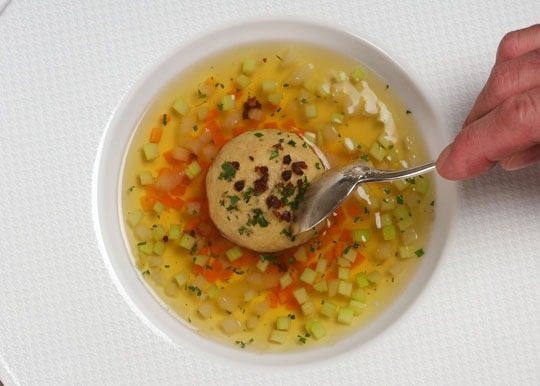
Matzo ball soup at its most elegant, with clarified broth and thoughtfully cut garnish. Photos by Donna Turner Ruhlman
I had a question for my friend and neighbor Lois Baron and her email ended thus: “By the way, Passover is almost here and I am making more schmaltz plus some highpowered horseradish. Hope you have a fabulous Easter. Love the schmaltz lady.”
I do love the Schmaltz Lady! She helped educate me in the ways of schmaltz, the glorious rendered chicken fat that makes everything taste better, especially things like these matzo balls, one of the greatest chicken soup garnishes ever! The photos above and below are from our app for iPads (minis too): The Book of Schmaltz: A Love Song to a Forgotten Fat, a short cookbook with twenty recipes for traditional Jewish dishes (kishke, cholent), as well as contemporary recipes putting this great fat to use (savory brioche, vichyssoise) and great photography of all the dishes. (Here’s the video I made for the app; David Leite reviews the app glowingly at Leite’s Culinaria.)
The good folks of Edamam, a food-search database that aims to make finding good things to eat easier, are doing a giveaway of the app starting today on their Pinterest board.
Here in Cleveland, it’s cold and gloomy and I feel that some chicken soup with matzo balls, rustic as below, will be good for body and soul. It doesn’t have to be rustic, though; it can be four-star elegant if you put some craft into it!
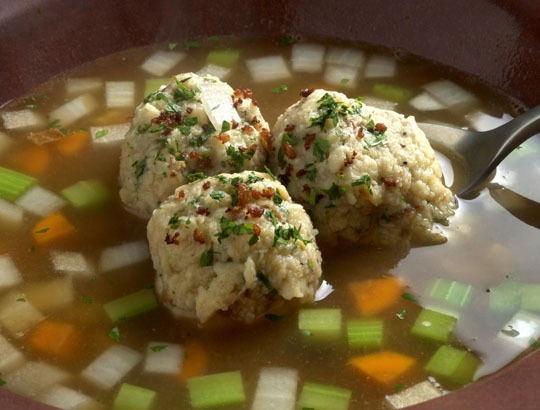
Matzo balls in soup can be plain, as here, or, at top, elegant. Either way they’re delicious.
There are two camps when it comes to matzo balls: those who prefer sinkers and those who like them light. I prefer the latter so you’ll find that these are light and fluffy.
Classic Chicken Soup with Matzo Balls
AKA Mr. Fluffies
Matzo Balls
1 cup/140 grams matzo meal (or 4 squares of matzo, well pulverized in a food processor)
4 eggs, beaten
1/4 cup/60 grams schmaltz, melted (or, sigh, vegetable oil)
1/4 cup/30 grams gribenes (optional)
1/4 cup/60 milliliters chicken stock or water
1 teaspoon baking powder
1 teaspoon salt
1/2 teaspoon ground black pepper
Combine all the ingredients in a bowl and stir until they are all thoroughly mixed. Cover with plastic wrap and set aside at room temperature for 30 minutes, or refrigerate for up to 24 hours.
With damp hands, form the matzo mixture into 8 golf ball-sized orbs (they will double in size).
For the Soup
2 tablespoons/30 grams schmaltz (or canola oil if you’re low on schmaltz)
1 Spanish onion, cut into medium dice
2 carrots, peeled and cut into medium dice (optional)
2 ribs celery, cut into medium dice (optional)
2 quarts/2 liters chicken stock
salt to taste
8 matzo balls
Chopped gribenes and parsley for finishing garnish (optional)
In a large pot, melt the schmaltz over high heat, add the onion (and carrots and celery if using), and cook for a few minutes, just until the onion is translucent, giving it a four-finger pinch of salt as you stir.
Add the stock and bring it to a simmer. Taste it and add more salt, if necessary. Add the matzo balls and let the soup return to a simmer. Reduce the heat to low, cover the pot, and simmer until the matzo balls are cooked through, 20 to 30 minutes.
Serves 8
If you liked this post, you might be interested in these links:
My post on making your own consommé and clarifying it.
Learn how Matzo is made.
Take a look at Epicurious’s Passover guide, where a few recipes from Schmaltz are featured.
A brief history of the Jewish holiday of Passover.
© 2013 Michael Ruhlman. Photo © 2013 Donna Turner Ruhlman. All rights reserved.
March 18, 2013
Making Mayonnaise

You can’t buy this kind of mayonnaise. Photo by Donna Turner Ruhlman.
Yet again finishing up a manuscript with mayonnaise on my mind, and I always think of Donna’s lovely images, captured when spring light was coming through our kitchen window. I could look at these forever (and now, as I couldn’t five years ago, I can post them to Twitter). Thanks, Donna! And remember, the emulsion is less about the yolk than about the liquid.
Originally posted on May 21, 2008
Finishing up the revisions of a manuscript and going over some fat-based sauces has returned me to the mayonnaise. Like the popover, it’s the story of a great transformation. Yolk, lemon juice, salt, and oil.
There simply isn’t anything like it when you make it yourself—you can’t buy this stuff. But I’ll bet you have everything you need to make it right now. I’ll include a recipe at the end of this post.
Two things are critical to remember for those who have never made a mayonnaise. You need enough liquid (water or lemon juice) to maintain the emulsion, so don’t skimp on this. Second, begin adding the oil very slowly, just a couple drops of oil off the end of a spoon into the yolk while whisking, then another few drops. This establishes the emulsion. Then you can add the oil in a steadier stream.
Donna took these pictures several weeks ago using natural light in our kitchen and frankly, they’re why I wanted to post about mayonnaise. But I hope they inspire you to make your own.
You will have taken a tasteless fluid oil and transformed it into an ethereal sauce through craftsmanship and care. Add a tablespoon of minced shallot, and maybe a little extra lemon juice for an extraordinary dipping sauce for an artichoke, or blanched and shocked cauliflower, or to put on some boiled new potatoes. It’s magical stuff. Or just put it on a BLT—it’ll be the best sandwich you’ve had in a long time.
Here’s the recipe adapted from Charcuterie:
Mayonnaise
1 large organic egg yolk
1/2 teaspoon/5 grams salt
1 teaspoon/5 milliliters water
1 teaspoon/5 milliliters lemon juice (or 2 for a lemony mayo)
1 cup/250 milliliters vegetable oil
Combine the yolk, salt, water, and lemon juice in a 2.5-quart bowl. Fold a hand towel into a ring on the counter and set the bowl in this ring to hold it steady while you whisk. Using a sauce or balloon whip (whisk), stir the ingredients together.
Add the oil slowly while whisking vigorously. It helps to measure out your oil into a cup that pours well in a wire-thin stream; alternatively, you can start your emulsion by drizzling the oil off a spoon, then pouring the oil after the emulsion has begun. Add a few drops of oil as you begin to whisk; when the emulsion becomes creamy, you may increase the speed with which you add the oil to a thin stream. From the beginning the mixture should be thick enough to hold its shape and look luxuriously creamy. Add the oil too quickly and it will break, that is, it will turn soupy. When all the oil is incorporated, add additional lemon juice to taste. If the mayonnaise is too thick, it can be thinned by whisking in a little water.
If it breaks, put a teaspoon of water in a clean bowl and start the process over by drizzling in the broken mayonnaise while whisking.
URGENT UPDATE AND MSG TO BECKS & POSH AND RIPERT: From Shannon at momwantsacure: “Ha!! I just proved Eric Ripert and Becks & Posh WRONG!!!!! Tell them that menstruating women can make a fabulously perfect mayonnaise!”
If you liked this post on homemade mayonnaise, check out these other links:
My post on the Badass Perforated (aka egg) Spoon—use melted butter and three eggs whipped over gentle heat for Hollandaise and eggs benny!
Here are some ideas on different flavor combinations for deviled eggs.
Personality type can be determined by how you eat an egg.
11 other uses of mayo from Reader’s Digest, which includes cleaning piano keys.
© 2013 Michael Ruhlman. Photo © 2013 Donna Turner-Ruhlman. All rights reserved
March 15, 2013
Friday Cocktail Hour: The Vesper

The classic Vespar. Photo by Donna Turner Ruhlman.
Having recently delighted in Skyfall with son James, and with a fresh bottle of Lillet on hand, and having never tried this preposterous sounding cocktail with the beguiling name, well, I had to give the Vesper a go. Checking my resources I noticed that one, the very elegant and excellent ratio-oriented book, See Mix Drink, includes a twist of orange rather than the customary lemon twist. I contacted the author, Brian D.Murphy, who explained his rational via email:
“Alessandro, the bartender at the Duke’s Hotel in London (where the cocktail originated), replaces the lemon with an orange peel. When I visited there and asked why, he said it pairs much better with the hint of orange in the Lillet Blanc – so well, in fact, that he believes the lemon peel in the original was a mistake. After tasting his version, I was hooked.”
As am I. The Lillet, a French aperitif, really makes this drink distinctive and the orange is a perfect finish. It’s a strong drink, which many on twitter yesterday suggest I needed after a heated rant, but I wasn’t ready to go the full James Bond 3:1 gin to vodka ounce-wise (if only because the drink would be warm by the time i finished half a cup of booze). So to simplify, I follow Murphy’s version extactly, 2 : 1 : 1/2. If you want the exact version, happily reprinted on the cocktail’s wiki page, I recommend 30 grams gin, 10 grams vodka, five grams Lillet. And, after a good rant, perhaps a second.
Important: this is a Bond cocktail and so must be shaken, something I deplore because I hate ice chips in my martini. But Bond gets what he’s after so I recommend a vigorous shaking, with a double strain to avoid those diluting ice fragments.
Happy Friday all!
The Vesper
2 ounces gin
1 ounce vodka
1/2 ounce Lillet
orange twist
Combine, shake like mad, strain through strainer to catch ice chips.
If you liked this post, you might be interested in these links:
A few other other gin cocktails: Traverse City Zinger, The Southside, and Negroni.
Two of Emilia’s favorite gins are from Few Spirits and Death’s Door Spirits.
TasteSpotting shares various other cocktails made with Lillet.
An interesting post about the history and marketing of Lillet.
© 2013 Michael Ruhlman. Photo © 2013 Donna Turner Ruhlman. All rights reserved.
March 14, 2013
Cook Your Own Food. Eat What You Want.(Think for Yourself.)

Salt and fat are good for you! Salt and fat are bad for you! Oh my God, what should I do? Everyone, run and hide! Photo by Donna Turner Ruhlman
I’d have thought that an article in last Sunday’s New York Times Magazine, Eat Your Heart Out by Gretchen Reynolds, would have made me happy. I’ve long argued that America’s terror of fat and salt is misguided and blown grossly out of proportion. But all the piece did was make me mad.
It notes a study that found that men with heart disease who reduced their intake of meat and saturated fats and increased the polyunsaturated fats in their diet were more likely to die of a heart attack than the control group who maintained their customary diet. It noted the existence of a “small but unsettling body of data suggesting that consuming polyunsaturated oils … may … increase your risk of heart disease.” (There’s lots of hemming and hawing in the piece due to the contrarian nature of it, thus the ellipses; the Times even took it off their magazine page and threw it back into the blogs category, but I have the hard copy on my desk–the quotation is from the third paragraph.)
America doesn’t have an obesity problem, or a food problem, or a Big-Gulp-forcing-Mayor-Bloomberg-to-put-on-his-cape problem (though the fattest state in the country just passed a food anti-regulation bill lest they lose their right to ethereal sugar-laden gulps on that express train to diabetes land).
What America has is a living problem. America seems to think that the answer to how to eat can be found on the news, from studies, from your doctor (who’s reading the same reports you are and following the same party line now being contradicted by that “small body of unsettling data”), not even from your mayor.
The data that matters to me is the data I receive after I’ve finished eating something. Do I feel good after eating a roast chicken with gravy and mashed potatoes and a pile of shaved sautéed Brussels sprouts? Yes. How about after I eat a bag of Cheetos? Not so good. What does that mean? Think about it. Think. Do you feel good after you exercise? Yes, because it’s good for you. Or you can hunt for data on the Internets if you want The Truth. Go ahead, read up on it. Or watch all the “a new study finds” stories on the ABC Nightly News.
Part of the problem is our obsession with longevity rather than quality of life. Why can’t we become obsessed with good rather than long? Sure I’d prefer 90 healthy years to 75 healthy years. But do I want 75 healthy years followed by 5 years of mental and physical decline, followed by 10 years of increasing dementia that puts a strain on my family?
As Sherwin Nuland notes in his superb book How We Die, and as Julian Barnes underscores in Nothing to Be Frightened Of, death is life’s single certainty, but the manner of our death, short of killing ourselves, cannot be known or predetermined. Your manner of death is very likely to parallel the death of one of your relatives—in my case, and in order, heart attack, stroke, stomach cancer, 96 years (my maternal grandmother’s final decade spent in increasing darkness from untreated glaucoma, solitude, and depression, her mind sharp as when she was 30), and most recently the heart disease, emphysema, and lung cancer—due to decades of Luckies, what a name—that awaited my beloved dad, dead weeks before his three-score-and-ten. That’s right, it’s going to be genetics and environment (food and exercise, or lack thereof) that get you. And there’s not a whole lot Mayor Bloomberg can do to help you, I’m sorry to say.
Me, if I have a really good meal, al fresco, say, followed by an espresso and an eau de vie and someone offers me a cigarette? I’m going to have it. I love a cigarette. What a pleasure with, say, a grappa overlooking the harbor of Portofino on my 49th birthday. Damn, that was a good cigarette. But I have no intention of addicting myself again, because that will give me the lung cancer and emphysema that killed my dad. I’d sooner eat straight sugar than drink a regular Coke, but am I going to forgo duck confit and bacon so that I can eke out 90 years? Are you kidding me? Shoot me now.
I’m sorry, I just get so goddam sick of studies and data telling me how to live, reading about this or that new diet that’s going to take pounds off my body and add countless Sound of Music years to my life. My hunch is that people don’t actually want to live longer—I think people want to be happier, to be more at ease with who they are, to feel glad when they wake up rather than dreadful, to feel good at the end of the day instead of crummy. The South Beach diet is not going to do this for you. Show me the data on how to be happy and I’ll listen. That’s what people are after and they can’t get their fingers on it. It’s not in a damned diet book, that’s for sure. It’s more likely in a pot of minestrone simmering on the stove.
Me I’m going to enjoy the pleasures and bounty that are available, and recommend anyone still reading do the same. For me, it’s Donna and my family, good simple food, wine and spirits, stories, work that I care about. Do I want to lay eyes on a grandchild carrying my DNA? One day, of course, but that’s not up to me. What is up to me is the way I live my life and the great good fortune that I live in a country that allows me to make my own choices.
March 11, 2013
The Remarkable Ina Garten (with a side of minestrone)

Ina Garten’s minestrone soup. Photo by Donna Turner Ruhlman.
Tomorrow night at Playhouse Square, I’ll be hosting Ina Garten, aka the Barefoot Contessa, the brain and heart behind what has become an adored brand. And such is the subject of our talk, business and brands, as well as food and cooking. She, like me, is something of an accident—that is, Garten never set out to do what she is doing. She knew by age thirty that she didn’t want to be entombed as a policy wonk in D.C., so she put a low-bid offer on a prepared foods store in the Hamptons and got it. It had a felicitous name, which she kept, and with absolutely no training, she built it into a solid business, eventually branching out into catering. In 1996, after 18 years, she was ready to move on.
More or less as something to fill the hours while she figured out what the hell she was going to do for the rest of her life—she was pushing fifty, after all, time to get a move on for part II, the stock market, another business, perhaps—she wrote a cookbook. And she sold it to Clarkson Potter. Her store had been in the Hamptons, not Kansas, and powerful people, charmed by her warmth and savvy, had befriended her. But even an intro to the book by Martha Stewart didn’t merit a first run of 10,000 copies. The deal was good only if she agreed to buy half that number to sell at her store.
What did she do? She went the publisher one better, investing heavily in the book on photography, styling, and publicity. The 1999 book became a bestseller and Ina went from well known in the Hamptons to well known throughout the country.
A television show followed, though not without her initial resistance. But once it aired it was so honest, so lacking in the phony good cheer and bullshit that all but defined the dump-and-stir shows of the last decade, even cynincal chefs and Food Network trashers embraced it and her.
All of which is why I’m so eager to talk to her publicly at The State Theater tomorrow night at 8 p.m. Yes, I have a thing for no-bullshit, badass, wicked-smart business women who can cook. What can I say? Hope you’ll join us! (Details on Facebook, or at the initial link.)
I’d been wanting to make a minestrone for a while after my sister-in-law made one over the Thanksgiving weekend, and perusing Ina Garten’s new book, Barefoot Contessa Foolproof, in anticipation of tomorrow night, lo and behold! Done. And yep, it’s solid and delicious. Takes a few minutes of chopping, but it comes together in a flash. Be organized, and dinner’s ready in a half hour. (Though I do say I worry about the book’s commercial prospects, only 315 five-star reviews on Amazon….)
I say it all the time and I know Ina joins me: Cook your own food.
Winter Minestrone and Garlic Bruschetta
Good olive oil
4 ounces pancetta, ½-inch-diced
1½ cups chopped yellow onions
2 cups (½-inch-diced) carrots (3 carrots)
2 cups (½-inch-diced) celery (3 stalks)
2½ cups (½-inch-diced) peeled butternut squash
1½ tablespoons minced garlic (4 cloves)
2 teaspoons chopped fresh thyme leaves
1 (26-ounce) can or box diced tomatoes, such as Pomi
6 to 8 cups chicken stock, preferably homemade
1 bay leaf
Kosher salt and freshly ground black pepper
1 (15-ounce) can cannellini beans, drained and rinsed
2 cups cooked small pasta, such as tubetti
8 to 10 ounces fresh baby spinach leaves
½ cup good dry white wine
2 tablespoons store-bought pesto
Freshly grated Parmesan cheese, for serving
Garlic Bruschetta (recipe follows)
Heat 2 tablespoons of olive oil over medium heat in a large, heavy pot or Dutch oven. Add the pancetta and cook over medium-low heat for 6 to 8 minutes, stirring occasionally, until lightly browned. Add the onions, carrots, celery, squash, garlic, and thyme and cook over medium heat, stirring occasionally, for 8 to 10 minutes, until the vegetables begin to soften.
Add the tomatoes, 6 cups of the chicken stock, the bay leaf, 1 tablespoon salt, and 1½ teaspoons pepper to the pot. Bring to a boil, then lower the heat and simmer uncovered for 30 minutes, until the vegetables are tender.
Discard the bay leaf. Add the beans and cooked pasta and heat through. The soup should be quite thick but if it’s too thick, I add more chicken stock. Just before serving, reheat the soup, add the spinach, and toss with 2 big spoons (like tossing a salad). Cook just until the leaves are wilted. Stir in the white wine and pesto. Depending on the saltiness of the chicken stock, add another teaspoon or two of salt to taste. Serve large shallow bowls of soup with bruschetta on top. Sprinkle with Parmesan cheese, drizzle with olive oil, and serve hot.
Serves 6 to 8
Garlic Bruschetta
1 French baguette
Good olive oil
1 clove garlic, cut in half lengthwise
Preheat the oven to 425°F/218°C.
Slice the baguette at a 45 degree angle in ½-inch-thick slices. Brush both sides of the bread with olive oil and bake for 6 minutes, until lightly toasted. Take the slices out of the oven and rub the surface of each one with the cut clove of garlic.
Copyright 2012, Barefoot Contessa Foolproof, All Rights Reserved
Check out these other links:
See more recipes from Ina on the Food Network website.
An interesting article about Ina building her house in the Hamptons.
Take a peek into my considerably more modest online store.
© 2013 Michael Ruhlman. Photo © 2013 Donna Turner Ruhlman. All rights reserved.
Michael Ruhlman's Blog
- Michael Ruhlman's profile
- 354 followers




